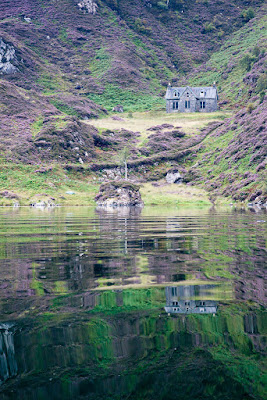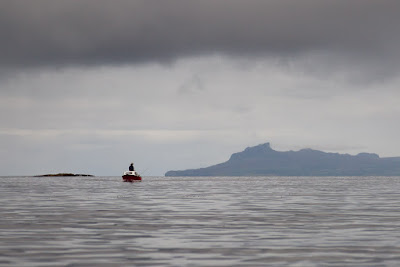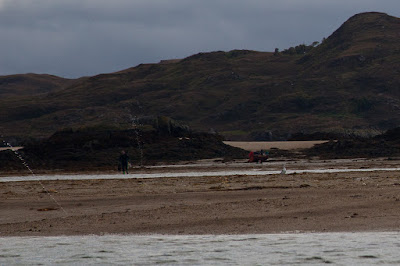Once we had entered the North Channel of Loch Moidart, we came across a substantial Victorian house nestling in a little north facing valley on Eilean Shona, the island which sits in the mouth of Loch Moidart.
It is Baramore school house and at one time about a dozen children were taught there. It is built on the opposite side of Eilean Shona from the other houses, reputedly because the wife of the island's owner did not want her peace to be disturbed by children! In August the purple heather and green bracken created lovely reflections on the still water but the hillside was silent. The children are long gone.
At the north end of Eilean Shona, a narrow neck of land joins it to the smaller Shona Beag. In the distance a wisp of smoke rose lazily in the still air. In the shelter of Loch Moidart, maritime forests of oak come right down to the sea shore.
As we made our way past Shona Beag, the view was dominated by the mist shrouded slopes of Beinn Resipol 845m, in the lands of Sunart.
We were now in a tidal channel, which dries to reveal a ford at low tide, Donald wound his fishing lines in but he still had 3m of water under his keel as it was high water.
Just as the ebb tide turned against us, we approached the east end of Shuna Beag and prepared to turn west, to continue our exploration of beautiful Loch Moidart.
Imagine you are at the edge of the sea on a day when it is difficult to say where the land ends and the sea begins and where the sea ends and the sky begins. Sea kayaking lets you explore these and your own boundaries and broadens your horizons. Sea kayaking is the new mountaineering.
Friday, September 16, 2011
Thursday, September 15, 2011
Going to work on an Eigg but treading carefully.
Neither Donald nor I slept well and we both rose early. Donald had slept in the boat with the cover on. He awoke to find he was getting wet from the condensation dripping from the cover. He then opened the cover, only to be eaten alive by midges. My problems were different, I had pitched my comfortable tent on some delightful machair but the pain in my knee was so bad that I hardly slept a wink. However, emerging into the still air of the morning with a view like this, over to the Small Isles of Muck, Eigg and Rum, was worth a sleepless night. After a hearty breakfast of bacon eggs and Cox-2 inhibitors we...
...set off an hour before high water and turned our backs to the open sea and Eigg, as we wanted to work our way, treading carefully, through the rock strewn North Channel of Loch Moidart.
From the sea it is quite difficult to spot the entrance...
...and once in, you find the tortuous channel is littered with rocks. Many were barely covered by the big spring tide.
I was quite happy to scrape over the occasional rock in my kayak but Donald needed to be a lot more careful in his boat.
Then we were in and the North Channel stretched away to the misty mountains of Moidart.
...set off an hour before high water and turned our backs to the open sea and Eigg, as we wanted to work our way, treading carefully, through the rock strewn North Channel of Loch Moidart.
From the sea it is quite difficult to spot the entrance...
...and once in, you find the tortuous channel is littered with rocks. Many were barely covered by the big spring tide.
I was quite happy to scrape over the occasional rock in my kayak but Donald needed to be a lot more careful in his boat.
Then we were in and the North Channel stretched away to the misty mountains of Moidart.
Wednesday, September 14, 2011
High and dry at day's end in Moidart
We landed on a shell sand beach in the lee of some skerries on the Moidart coastline. We had travelled so far south that Rum now lay behind Eigg on the horizon.
Donald's boat and engines are heavy but high tide was about 8pm and as we intended to launch about 8am the next morning, no hauling up the beach was required. I think I will stick with a sea kayak though!
As the sun set behind the Sgurr of Eigg...
...and as the receding tide left Donald's boat high and dry, we lit a fire on the beach. A bag of barbecue charcoal always makes a good heart for a fire and I had also bought a sack of logs from a petrol station on the road north to Arisaig.
Donald and I reminisced and put the World to rights as our baked potatoes (in tin foil) roasted on the fire...
Donald's boat and engines are heavy but high tide was about 8pm and as we intended to launch about 8am the next morning, no hauling up the beach was required. I think I will stick with a sea kayak though!
As the sun set behind the Sgurr of Eigg...
...and as the receding tide left Donald's boat high and dry, we lit a fire on the beach. A bag of barbecue charcoal always makes a good heart for a fire and I had also bought a sack of logs from a petrol station on the road north to Arisaig.
Donald and I reminisced and put the World to rights as our baked potatoes (in tin foil) roasted on the fire...
Labels:
beaches,
boats,
bonfires,
Eigg,
Moidart,
mountains,
photography,
Rum,
sea kayaking,
sunsets
Tuesday, September 13, 2011
A bumpy crossing of the Sound of Arisaig.
From Port nan Murrach, we pointed our bows to the east. We didn't bother exploring Port a' Bhathaich as it is a trap for most of the flotsam and jetsam in the area. Instead, we cut across its mouth and slipped inside Eilean a' Ghaill. It has the remains of a vitrified Iron Age fort on its summit. There is a great view from the top but it is a very steep scramble and although it is only 23m high (and in 2004 I almost skipped up), I knew that as far as I was concerned it could now just as easily have been the Inaccessible Pinnacle on Sgurr Dearg in the Cuillin.
We now had a choice, head up into Loch nam Uamh at the head of the Sound of Arisaig staying in the shelter of the lee of the Arisaig peninsula...
...but it got a little bit bumpy on the crossing especially as we approached the wind over spring tide conditions off Rubha Ghead a' Leighe. Photography stopped until we were well down the Smirisary coast and the water flattened again as in the photo above. Smirisary was a crofting community that survived until the end of the Second World War when it was abandoned. Nowadays, many of the old crofts have been restored as holiday homes.
It was too rough to land on the rocky shore at Smirisary and anyway we still had a way to go before we could finally pull up the boats on another shell sand beach.
We now had a choice, head up into Loch nam Uamh at the head of the Sound of Arisaig staying in the shelter of the lee of the Arisaig peninsula...
Photo by Donald Wilcox
...or head straight across the mouth of the Sound of Arisaig for the distant lands of Moidart. Well it was a no brainer, it was a broad reach on open water all the way to Moidart! At first the sea was nice and flat due to the shelter of Rubh Arisaig......but it got a little bit bumpy on the crossing especially as we approached the wind over spring tide conditions off Rubha Ghead a' Leighe. Photography stopped until we were well down the Smirisary coast and the water flattened again as in the photo above. Smirisary was a crofting community that survived until the end of the Second World War when it was abandoned. Nowadays, many of the old crofts have been restored as holiday homes.
It was too rough to land on the rocky shore at Smirisary and anyway we still had a way to go before we could finally pull up the boats on another shell sand beach.
Monday, September 12, 2011
The plight of the sand bees on the machair at Port nam Murrach.
I was able to nip inside the various reefs in my sea kayak but Donald had to take a wider line.
We had arranged to rendezvous at Port nan Murrach on the Arisaig peninsula.
It wasn't long before Donald joined me in this delightful cove...
Squalls of wind and rain were blasting down from the north but fortunately this one missed us and plastered Eigg instead.
Donald scrambled up the rocks of the surrounding ridges to see what the wind was doing...
...away to the north.
Meanwhile I reaquainted myself with the colony of the rare northern colletes mining bees. These are a solitary species but they make their single burrows in aggregates in the sandy machair. They are a threatened species and there are only a handful of locations on the Scottish mainland where they can still be found.
I was distressed to discover some recent visitors had built a fire right on top of the colony. I hope it was not a group of sea kayakers, most kayakers know to build fires below the high water mark.
While Donald continued to explore the ridges and other beaches in the area, I was content to sit on the rocks with a cup of coffee, admire the view and...
...the marvellous white shell sand. I am so grateful for sea kayaking. I could not have walked to such a wonderful spot.
Sunday, September 11, 2011
sea kayak photo delphin
Even when the sun is not shining, the Arisaig skerries at the mouth of Loch nan Ceall is a remarkable place. The dark rocks and seaweed are...
...interspersed with dazzling shell sand beaches. At low tide the skerries are high above the narrow channels and lagoons but even so...
...the peaks of the Rum Cuillin and...
...the Sgurr of Eigg dominate the scene.
The skerries are also home to large colonies of both common and grey seals. Interestingly Donald's motor boat got right up to them and I could sail very close but as soon as I started to paddle, they would slide into the water...
...and follow me, as seen in this photo from Donald's blog.
...interspersed with dazzling shell sand beaches. At low tide the skerries are high above the narrow channels and lagoons but even so...
...the peaks of the Rum Cuillin and...
...the Sgurr of Eigg dominate the scene.
The skerries are also home to large colonies of both common and grey seals. Interestingly Donald's motor boat got right up to them and I could sail very close but as soon as I started to paddle, they would slide into the water...
...and follow me, as seen in this photo from Donald's blog.
Saturday, September 10, 2011
The ejaculating spoots of Arisaig.
Donald and I first went on an expedition together to the
Skye Cuillin nearly 40 years ago. Sadly the passage of years has not been kind
to my knees and the Cuillin receded on the horizon behind us as we rounded
Eilean Ighe in small boat and kayak. The
sea was still rough after the fresh early morning winds. I cut through the
clapotis by the reefs but Donald in his boat had to take a wider line till we
entered the quiet waters of Arisaig North Channel at low water springs.
Inside the Arisaig skerries we entered a strange new world, which contrasted with the Rum Cuillin mountains on the horizon. The tidal lagoons inside the reefs had nearly emptied, exposing acres of sands that are usually still covered at most low tides.
We were surprised to see many small boats pulled up on the sand banks and the skerries seemed almost thronged with people. Many were carrying buckets and others seemed to be intently studying the sand at their feet.
Then as we drew closer we saw the most amazing sight. Mysterious jets of water were spouting high in the air all over the sands.
Inside the Arisaig skerries we entered a strange new world, which contrasted with the Rum Cuillin mountains on the horizon. The tidal lagoons inside the reefs had nearly emptied, exposing acres of sands that are usually still covered at most low tides.
We were surprised to see many small boats pulled up on the sand banks and the skerries seemed almost thronged with people. Many were carrying buckets and others seemed to be intently studying the sand at their feet.
Then as we drew closer we saw the most amazing sight. Mysterious jets of water were spouting high in the air all over the sands.
The water spouts come from razor clams (spoots in local
parlance), which live deep in the sands. The locals watch for the water jets
then sprinkle salt round the small hole through which they come. A few seconds
later the spoot pops up through the hole and is easily caught. They are
delicious.
Eigg1 has produced an amazing video of catching spoots on the nearby island of Eigg!













































